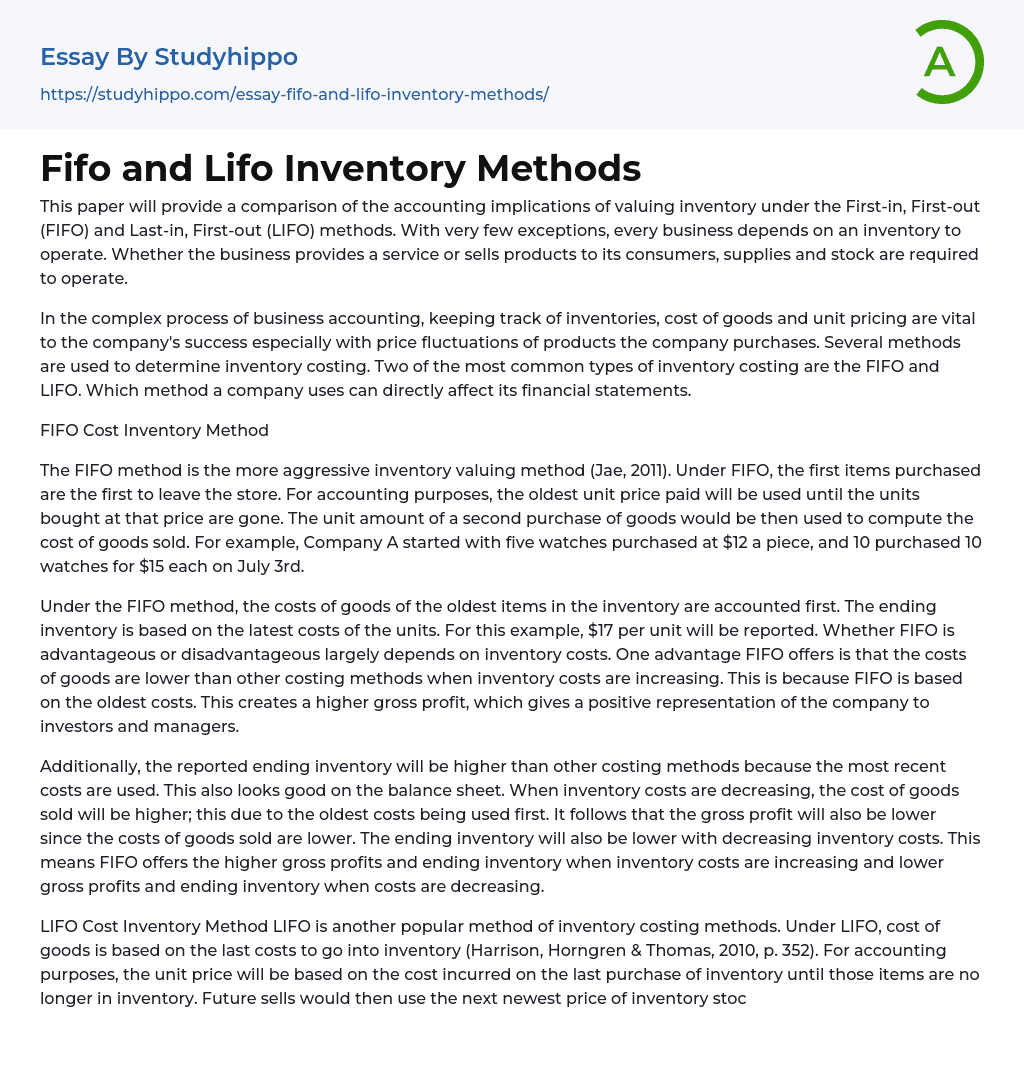This paper will provide a comparison of the accounting implications of valuing inventory under the First-in, First-out (FIFO) and Last-in, First-out (LIFO) methods. With very few exceptions, every business depends on an inventory to operate. Whether the business provides a service or sells products to its consumers, supplies and stock are required to operate.
In the complex process of business accounting, keeping track of inventories, cost of goods and unit pricing are vital to the company's success especially with price fluctuations of products the company purchases. Several methods are used to determine inventory costing. Two of the most common types of inventory costing are the FIFO and LIFO. Which method a company uses can directly affect its financial statements.
FIFO Cost Inventory
...Method
The FIFO method is the more aggressive inventory valuing method (Jae, 2011). Under FIFO, the first items purchased are the first to leave the store. For accounting purposes, the oldest unit price paid will be used until the units bought at that price are gone. The unit amount of a second purchase of goods would be then used to compute the cost of goods sold. For example, Company A started with five watches purchased at $12 a piece, and 10 purchased 10 watches for $15 each on July 3rd.
Under the FIFO method, the costs of goods of the oldest items in the inventory are accounted first. The ending inventory is based on the latest costs of the units. For this example, $17 per unit will be reported. Whether FIFO is advantageous or disadvantageous largely depends on inventory costs. One advantage FIFO offers is that th
costs of goods are lower than other costing methods when inventory costs are increasing. This is because FIFO is based on the oldest costs. This creates a higher gross profit, which gives a positive representation of the company to investors and managers.
Additionally, the reported ending inventory will be higher than other costing methods because the most recent costs are used. This also looks good on the balance sheet. When inventory costs are decreasing, the cost of goods sold will be higher; this due to the oldest costs being used first. It follows that the gross profit will also be lower since the costs of goods sold are lower. The ending inventory will also be lower with decreasing inventory costs. This means FIFO offers the higher gross profits and ending inventory when inventory costs are increasing and lower gross profits and ending inventory when costs are decreasing.
LIFO Cost Inventory Method LIFO is another popular method of inventory costing methods. Under LIFO, cost of goods is based on the last costs to go into inventory (Harrison, Horngren & Thomas, 2010, p. 352). For accounting purposes, the unit price will be based on the cost incurred on the last purchase of inventory until those items are no longer in inventory. Future sells would then use the next newest price of inventory stock. Using the example above of Company A, we can illustrate the cost of goods sold and ending inventory using the LIFO costing method. Compare the results with the FIFO example above.
- Accounts Receivable essays
- Auditor's Report essays
- Balance Sheet essays
- Costs essays
- Financial Audit essays
- International Financial Reporting Standards essays
- Tax essays
- Accountability essays
- Cash essays
- Principal essays
- Management Accounting essays
- Internal Control essays
- Accounting Software essays
- Cash Flow essays
- Net Present Value essays
- Income Statement essays
- Accounting essays
- Andrew Carnegie essays
- Automation essays
- Business Cycle essays
- Business Intelligence essays
- Business Model essays
- Business Operations essays
- Business Software essays
- Cooperation essays
- Cooperative essays
- Corporate Social Responsibility essays
- Corporation essays
- Customer Relationship Management essays
- Family Business essays
- Franchising essays
- Harvard Business School essays
- Harvard university essays
- Human Resource Management essays
- Infrastructure essays
- Inventory essays
- Logistics essays
- Management essays
- Manufacturing essays
- Market essays
- Marketing essays
- Multinational Corporation essays
- News Media essays
- Online Shopping essays
- Quality Assurance essays
- Richard Branson essays
- Sales essays
- Selling essays
- Shopping Mall essays
- Small Business essays




